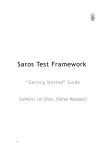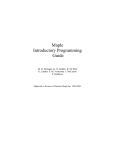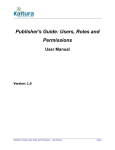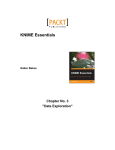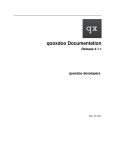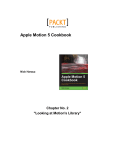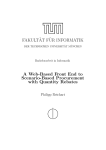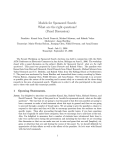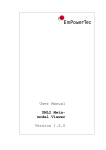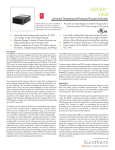Download Apache Struts 2 Web Application Development:
Transcript
Apache Struts 2
Web Application Development:
Dave Newton
Chapter 15
"Documenting our Application"
In this package, you will find:
A Biography of the author of the book
A preview chapter from the book, Chapter 15. "Documenting our Application"
A synopsis of the book’s content
Information on where to buy this book
About the Author
Dave has been programming for as long as he can remember, and probably a bit longer
than that. He began by playing a Star Trek game on a library computer, and quickly
graduated to educating his grade school teachers about computers and the BASIC
language. Receiving a TRS-80 Model 1 was pretty much the end of his social life, and
he's never looked back.
A diverse background in both programming languages and problem spaces has provided
him with a wide range of experience. Using a diverse set of languages, which includes
Pascal, Forth, Fortran, Lisp, Smalltalk, assembly, C/C++, Java, and Ruby, brings an
appreciation for many programming paradigms. Working on AI, embedded systems,
device drivers, and both desktop and web application programming, has brought him an
appreciation for the problems and solutions that each environment offers.
Even after thirty years of typing in his first infinite loop, he's still entertained by the
process of programming. He never tires of looking for ways to do less work, and is
convinced that he should never have to repeat himself to a computer. He still occasionally
writes an infinite loop.
For More Information:
http://www.packtpub.com/apache-struts-2-web-application-developmentbeginners-guide/book
Apache Struts 2
Web Application Development
Struts 2.1 is a modern, extensible, agile web application framework, which is suitable for
both small- and large-scale web applications.
The book begins with a comprehensive look at the basics of Struts 2.1, interspersed with
detours into more advanced development topics. You'll learn about configuring Struts 2.1
actions, results, and interceptors via both XML and Java annotations. You'll get an
introduction to most of the Struts 2.1 custom tags, and also learn how they can assist in
rapid application prototyping and development.
From there, you'll make your way into Struts 2.1's strong support for form validation and
type conversion, which allows you to treat your form values as domain objects without
cluttering your code. A look at Struts 2.1's interceptors is the final piece of the Struts 2.1
puzzle, which allows you to leverage the standard Struts 2 interceptors, as well as
implement your own custom behavior.
After covering Struts 2.1, you'll journey into the world of JavaScript (a surprisingly
capable language), the Document Object Model (DOM), and CSS, and learn how to
create clean and concise client-side behavior. You'll leverage that knowledge as you
move on to Struts 2 themes and templates, which give you a powerful way to encapsulate
site-wide user interface behavior.
The book closes with a look at some tools that make the application development life
cycle easier to manage, particularly in a team environment, and more automatic.
What This Book Covers
Chapter 1 gives us a bird's-eye view of Struts 2 and examines some useful techniques of
lightweight, agile development.
Chapter 2 gives an introduction to Struts 2 application configuration, using both XML
and annotations. It also covers the beginning of our sample application, RecipeBox.
Chapter 3 covers some of the functionality provided by Struts 2's ActionSupport class,
including I18N, and a first look at form validation. It also covers some basic RecipeBox
functionality after gathering some user stories.
For More Information:
http://www.packtpub.com/apache-struts-2-web-application-developmentbeginners-guide/book
Chapter 4 examines several common, standard Struts 2 result types. It also covers how to
write our own custom result types.
Chapter 5 gives an in-depth look at the generic Struts 2 custom tags. These include tags
for iteration, list generation, conditionals, and internationalization (I18N).
Chapter 6 continues our exploration of Struts 2 custom tags, focusing especially on its
form tags.
Chapter 7 examines Struts 2 form validation, including both XML and
annotation-driven validation. It also teaches more about how Struts 2 converts
our form values into domain objects, and shows how to create our own type converters to
handle custom data types.
Chapter 8 finishes our comprehensive introduction to Struts 2, by checking out
the included Struts 2 interceptors. It also discusses how to write and configure our
own interceptors.
Chapter 9 looks at how to handle errors in Struts 2, as well as discusses error and
exception handling in general. It also covers some general Java logging topics, focusing
on using Apache Commons Logging and Log4J.
Chapter 10 explores how to best leverage JavaScript and how to keep it modular.
Chapter 11 covers the client-side functionality, which depends on more than JavaScript.
By using CSS and the DOM effectively, we can accomplish a lot with a minimal amount
of code.
Chapter 12 covers Struts 2 themes and templates. The themes and templates in Struts 2
allow for application-wide functionality on the client side, keeping our JSP pages
lightweight and adaptable. Rather than writing boilerplate HTML on our pages, we can
separate it into themes and templates.
Chapter 13 takes a look at some of Struts 2's built-in support for Ajax using the Dojo
tags. It also covers the Struts 2 REST plug-in that furthers our "convention over
configuration" path.
Chapter 14 covers how to apply the TDD concepts to several testing aspects, including
unit, functional, and acceptance tests.
Chapter 15 looks at many aspects of documentation, including "self-documenting" code,
Javadocs, generators, methodologies, and so on, with a focus on automating
as much documentation as possible.
For More Information:
http://www.packtpub.com/apache-struts-2-web-application-developmentbeginners-guide/book
Documenting our Application
Every developer's favorite task is documenting their application (or so I've heard).
As irritating as documentation can be, delivering a complete solution implies
comprehensive, usable documentation. This goes beyond (but includes) typical
Javadocs. However, more is required in order to understand how a particular
application works, how its parts fit together, where dependencies lie, and so on. Even
us, the developers, benefit from having a wide variety of documentation available.
In this chapter, we'll look at the ways in which we can document our applications,
coding styles that can aid in understanding, tools and techniques for creating
documentation from application artifacts, different types of documentation for
different parties, and so on.
Documenting Java
Everybody knows the basics of documenting Java, so we won't go into much
detail. We'll talk a bit about ways of writing code whose intention is clear, mention
some Javadoc tricks we can use, and highlight some tools that can help keep our
code clean. Clean code is one of the most important ways we can document our
application. Anything we can do to increase readability will reduce confusion later
(including our own).
For More Information:
http://www.packtpub.com/apache-struts-2-web-application-developmentbeginners-guide/book
Documenting our Application
Self-documenting code
We've all heard the myth of self-documenting code. In theory, code is always clear
enough to be easily understood. In reality, this isn't always the case. However, we
should try to write code that is as self-documenting as possible.
Keeping non-code artifacts in sync with the actual code is difficult. The only artifact
that survives a project is the executable, which is created from code, not comments.
This is one of the reasons for writing self-documenting code. (Well, annotations,
XDoclet, and so on, make that somewhat less true. You know what I mean.)
There are little things we can do throughout our code to make our code read as much
like our intent as possible and make extraneous comments just that: extraneous.
Document why, not what
Over-commenting wastes everybody's time. Time is wasted in writing a comment,
reading it, keeping that comment in sync with the code, and, most importantly, a lot
of time is wasted when a comment is not accurate.
Ever seen this?
a += 1; // increment a
This is the most useless comment in the world.
Firstly, it's really obvious we're incrementing something, regardless of what that
something is. If the person reading our code doesn't know what += is, then we
have more serious problems than them not knowing that we're incrementing, say,
an array index.
Secondly, if a is an array index, we should probably use either a more common array
index or make it obvious that it's an array index. Using i and j is common for array
indices, while idx or index is less common. It may make sense to be very explicit in
variable naming under some circumstances. Generally, it's nice to avoid names such as
indexOfOuterArrayOfFoobars. However, with a large loop body it might make sense
to use something such as num or currentIndex, depending on the circumstances.
With Java 1.5 and its support for collection iteration, it's often possible to do away
with the index altogether, but not always.
[ 310 ]
For More Information:
http://www.packtpub.com/apache-struts-2-web-application-developmentbeginners-guide/book
Chapter 15
Make your code read like the problem
Buzzphrases like Domain Specific Languages (DSLs) and Fluent Interfaces
are often heard when discussing how to make our code look like our problem.
We don't necessarily hear about them as much in the Java world because other
languages support their creation in more "literate" ways. The recent interest in
Ruby, Groovy, Scala, and other dynamic languages have brought the concept back
into the mainstream.
A DSL, in essence, is a computer language targeted at a very specific problem. Java
is an example of a general-purpose language. YACC and regular expressions are
examples of DSLs that are targeted at creating parsers and recognizing strings of
interest respectively.
DSLs may be external, where the implementing language processes the DSL
appropriately, as well as internal, where the DSL is written in the implementing
language itself. An internal DSL can also be thought of as an API or library, but one
that reads more like a "little language".
Fluent interfaces are slightly more difficult to define, but can be thought of as an
internal DSL that "flows" when read aloud. This is a very informal definition, but
will work for our purposes.
Java can actually be downright hostile to some common DSL and fluent techniques for
various reasons, including the expectations of the JavaBean specification. However, it's
still possible to use some of the techniques to good effect. One typical practice of fluent
API techniques is simply returning the object instance in object methods. For example,
following the JavaBean specification, an object will have a setter for the object's
properties. For example, a User class might include the following:
public class User {
private String fname;
private String lname;
public void setFname(String fname) { this.fname = fname; }
public void setLname(String lname) { this.lname = lname; }
}
Using the class is as simple as we'd expect it to be:
User u = new User();
u.setFname("James");
u.setLname("Gosling");
[ 311 ]
For More Information:
http://www.packtpub.com/apache-struts-2-web-application-developmentbeginners-guide/book
Documenting our Application
Naturally, we might also supply a constructor that accepts the same parameters.
However, it's easy to think of a class that has many properties making a full
constructor impractical. It also seems like the code is a bit wordy, but we're
used to this in Java. Another way of creating the same functionality is to include
setter methods that return the current instance. If we want to maintain JavaBean
compatibility, and there are reasons to do so, we would still need to include normal
setters, but can still include "fluent" setters as shown here:
public User fname(String fname) {
this.fname = fname;
return this;
}
public User lname(String lname) {
this.lname = lname;
return this;
}
This creates (what some people believe is) more readable code. It's certainly shorter:
User u = new User().fname("James").lname("Gosling");
There is one potential "gotcha" with this technique. Moving initialization into
methods has the potential to create an object in an invalid state. Depending on the
object this may not always be a usable solution for object initialization.
Users of Hibernate will recognize the "fluent" style, where method chaining is used
to create criteria. Joshua Flanagan wrote a fluent regular expression interface, turning
regular expressions (already a domain-specific language) into a series of chained
method calls:
Regex socialSecurityNumberCheck =
new Regex(Pattern.With.AtBeginning
.Digit.Repeat.Exactly(3)
.Literal("-").Repeat.Optional
.Digit.Repeat.Exactly(2)
.Literal("-").Repeat.Optional
.Digit.Repeat.Exactly(4)
.AtEnd);
Whether or not this particular usage is an improvement is debatable, but it's certainly
easier to read for the non-regex folks.
[ 312 ]
For More Information:
http://www.packtpub.com/apache-struts-2-web-application-developmentbeginners-guide/book
Chapter 15
Ultimately, the use of fluent interfaces can increase readability (by quite a bit in most
cases), may introduce some extra work (or completely duplicate work, like in the
case of setters, but code generation and/or IDE support can help mitigate that), and
may occasionally be more verbose (but with the benefit of enhanced clarity and IDE
completion support).
Personally, I'm of the opinion that regular expressions are so incredibly important
that it's worth learning them in their native form, as they can be used in many
environments, including the IDEs so loved by Java developers. Large expressions can
be broken down into components and created by concatenating strings. But the point
here is more about the style of fluent programming, rather than this specific example.
Contract-oriented programming
Aspect-oriented programming (AOP) is a way of encapsulating cross-cutting
functionality outside of the mainline code. That's a mouthful, but essentially it
means is that we can remove common code that is found across our application and
consolidate it in one place. The canonical examples are logging and transactions, but
AOP can be used in other ways as well.
Design by Contract (DbC) is a software methodology that states our interfaces
should define and enforce precise specifications regarding operation.
"Design by Contract" is a registered trademark of Interactive Software
Engineering Inc. Other terms include Programming by Contract (PbC),
or my personal favorite, Contract Oriented Programming (COP), which
is how I'll refer to it from now on. I have a lot of respect for Eiffel and its
creator, but this type of trademarking bothers me. Maybe I'll trademark
"Singleton"?!
How does COP help create self-documenting code? Consider the following portion
of a stack implementation:
public void push(final Object o) {
stack.add(o);
}
This seems simple enough. The information available to us is that we can push an
object, whatever pushing means.
[ 313 ]
For More Information:
http://www.packtpub.com/apache-struts-2-web-application-developmentbeginners-guide/book
Documenting our Application
What happens if we attempt to push a null? Let's assume that for this
implementation, we don't want to allow pushing a null onto the stack.
/**
* Pushes non-null objects on to stack.
*/
public void push(final Object o) {
if (o == null) return;
stack.add(o);
}
Once again, this is simple enough. We'll add the comment to the Javadocs stating
that null objects will not be pushed (and that the call will fail/return silently). This
will become the "contract" of the push method—captured in code and documented
in Javadocs.
The contract is specified twice—once in the code (the ultimate arbiter) and again
in the documentation. However, the user of the class does not have proof that the
underlying implementation actually honors that contract. There's no guarantee that
if we pass in a null, it will return silently without pushing anything.
The implied contract can change. We might decide to allow pushing nulls. We
might throw an IllegalArgumentException or a NullPointerException on a
null argument. We're not required to add a throws clause to the method declaration
when throwing runtime exceptions. This means further information may be lost in
both the code and the documentation.
As hinted, Eiffel has language-level support for COP with the require/do/ensure/
end construct. It goes beyond the simple null check in the above code. It actively
encourages detailed pre- and post-condition contracts. An implementation's push()
method might check the remaining stack capacity before pushing. It might throw
exceptions for specific conditions. In pseudo-Eiffel, we'd represent the push()
method in the following way:
push (o: Object)
require
o /= null
do
-- push
end
A stack also has an implied contract. We assume (sometimes naively) that once
we call the push method, the stack will contain whatever we pushed. The size
of the stack will have increased by one, or whatever other conditions our stack
implementation requires.
[ 314 ]
For More Information:
http://www.packtpub.com/apache-struts-2-web-application-developmentbeginners-guide/book
Chapter 15
One aim of COP is to formalize the nature of contracts. Languages such as Eiffel
have one solution to that problem, and having it built-in at the language level
provides a consistent means of expressing contracts.
Java, of course, doesn't have built-in contracts. However, it does contain a mechanism
that can be used to get some of the benefits for a conceptually-simple price. The
mechanism is not as complete, or as integrated, as Eiffel's version. However, it
removes contract enforcement from the mainline code, and provides a way for both
sides of the software to specify, accept, and document the contracts themselves.
Removing the contract information from the mainline code keeps the implementation
clean and makes the implementation code easier to understand. Having programmatic
access to the contract means that the contract could be documented automatically
rather than having to maintain a disconnected chunk of Javadoc.
SpringContracts
SpringContracts is a beta-level Java COP implementation based on Spring's AOP
facilities, using annotations to state pre- and post-contract conditions. It formalizes
the nature of a contract, which can ease development.
Let's consider our VowelDecider that was developed through TDD. We can also use
COP to express its contract (particularly the entry condition). This is a method that
doesn't alter state, so post conditions don't apply here.
Our implementation of VowelDecider ended up looking (more or less) like this:
public boolean decide(final Object o) throws Exception {
if ((o == null) || (!(o instanceof String))) {
throw new IllegalArgumentException(
"Argument must be a non-null String.");
}
String s = (String) o;
return s.matches(".*[aeiouy]+.*");
}
Once we remove the original contract enforcement code, which was mixed
with the mainline code, our SpringContracts @Precondition annotation looks
like the following:
@Precondition(condition="arg1 != null && arg1.class.name == 'java.
lang.String'",
message="Argument must be a non-null String")
public boolean decide(Object o) throws Exception {
String s = (String) o;
return s.matches(".*[aeiouy]+.*");
}
[ 315 ]
For More Information:
http://www.packtpub.com/apache-struts-2-web-application-developmentbeginners-guide/book
Documenting our Application
The pre-condition is that the argument must not be null and must be (precisely)
a string. (Because of SpringContracts' Expression Language, we can't just say
instanceof String in case we want to allow string subclasses.)
We can unit-test this class in the same way we tested the TDD version. In fact,
we can copy the tests directly. Running them should trigger test failures
on the null and non-string argument tests, as we originally expected an
IllegalArgumentException. We'll now get a contract violation exception
from SpringContracts.
One difference here is that we need to initialize the Spring context in our test. One
way to do this is with JUnit's @BeforeClass annotation, along with a method that
loads the Spring configuration file from the classpath and instantiates the decider as
a Spring bean. Our class setup now looks like this:
@BeforeClass public static void setup() {
appContext = new ClassPathXmlApplicationContext(
"/com/packt/s2wad/applicationContext.xml");
decider = (VowelDecider)
appContext.getBean("vowelDecider");
}
We also need to configure SpringContracts in our Spring configuration file. Those
unfamiliar with Spring's (or AspectJ's) AOP will be a bit confused. However, in the
end, it's reasonably straightforward, with a potential "gotcha" regarding how Spring
does proxying.
<aop:aspectj-autoproxy proxy-target-class="true"/>
<aop:config>
<aop:aspect ref="contractValidationAspect">
<aop:pointcut id="contractValidatingMethods"
expression="execution(*
com.packt.s2wad.example.CopVowelDecider.*(..))"/>
<aop:around pointcut-ref="contractValidatingMethods"
method="validateMethodCall"/>
</aop:aspect>
</aop:config>
<bean id="contractValidationAspect"
class="org.springcontracts.dbc.interceptor.
ContractValidationInterceptor"/>
<bean id="vowelDecider"
class="com.packt.s2wad.example.CopVowelDecider" />
[ 316 ]
For More Information:
http://www.packtpub.com/apache-struts-2-web-application-developmentbeginners-guide/book
Chapter 15
If most of this seems like a mystery, that's fine. The SpringContracts documentation
goes into it a bit more and the Spring documentation contains a wealth of
information regarding how AOP works in Spring. The main difference between
this and the simplest AOP setup is that our autoproxy target must be a class,
which requires CGLib. This could also potentially affect operation.
The only other modification is to change the exception we're expecting to
SpringContract's ContractViolationCollectionException, and our test
starts passing. These pre- and post-condition annotations use the @Documented
meta-annotation, so the SpringContracts COP annotations will appear in the
Javadocs. It would also be possible to use various other means to extract and
document contract information.
Getting into details
This mechanism, or its implementation, may not be a good fit for every situation.
Runtime performance is a potential issue. As it's just some Spring magic, it can be
turned off by a simple configuration change. However, if we do, we'll lose the value
of the on-all-the-time contract management.
On the other hand, under certain circumstances, it may be enough to say that once
the contracts are consistently honored under all of the test conditions, the system
is correct enough to run without them. This view holds the contracts more as
an acceptance test, rather than as run-time checking. Indeed, there is an overlap
between COP and unit testing as the way to keep code honest. As unit tests aren't
run all the time, it may be reasonable to use COP as a temporary runtime unit test or
acceptance test.
Javadocs
We'll cover only a few things regarding Javadocs. I'm sure we're all very familiar
with them, but there are a few tips that might be helpful occasionally.
Always write Javadocs!
The first bit of advice is to always write Javadocs, except when they're not really
needed. Getters and setters that have no additional functionality really don't need
them. However, as soon as a getter or setter does more than just get or set its value,
it may deserve documentation. Even minor functionality that's trivial to understand
when looking at the code may deserve Javadocs. We may not have access to the
source or we may only want to look at the API documentation.
[ 317 ]
For More Information:
http://www.packtpub.com/apache-struts-2-web-application-developmentbeginners-guide/book
Documenting our Application
The first sentence
The first sentence of a Javadoc comment is used as the summary documentation.
It isn't necessary to encapsulate every nuance of the member being documented in
the first sentence, but it's important to give a very clear and concise overview of the
member. By default, the first sentence is everything up to the first "." (period). Some
tools will complain if the first sentence is not properly terminated.
The proper way to describe the grammar of the first sentence is something along
the lines of: "use a verb phrase in the third person declarative form." What does that
mean in real life?
/**
* Builds and returns the current list of ingredients.
*
* @return List of ingredients.
*/
public List<Ingredient> buildIngredientList() { ... }
In the case of methods, the Javadoc summary should answer the question: "What
does this member do?" One answer could be: "buildIngredientList() builds and
returns the list of ingredients." This is opposed to saying something such as "Build
and return list of ingredients", which doesn't work as an answer to the question. This
is the "verb phrase" part.
The "third person declarative" part (informally) means that we answer the question
as directly as possible. Sentence fragments are okay here. Additional exposition
harms clarity. For example, we probably would not want to write the following:
/**
* This method builds and returns the current list
* of ingredients.
*/
That's not a direct answer to the question "What does buildIngredientList() do?".
Therefore, this probably is not the best style of documentation.
This method is simple enough. Therefore, we may not need the @return Javadoc tag.
What it returns is already specified in the first sentence. However, some tools may
complain about missing Javadoc tags.
For variables, a simple descriptive sentence such as the following is usually fine:
/** Pre-built recipe summary. */
private String summary;
[ 318 ]
For More Information:
http://www.packtpub.com/apache-struts-2-web-application-developmentbeginners-guide/book
Chapter 15
Is it okay to have member variables without Javadocs? The answer is yes, if the
purpose is self-evident from the name. However, if our build process includes a tool
that enforces Javadoc requirements, we'll either get irritating warnings or we'll need
to specify what to exclude from checking.
If there aren't any Javadoc requirements, then all bets are off. However, bear in
mind that Javadocs are also used by the IDE to provide information in various forms
such as roll-over Javadoc pop-ups. It often boils down to whether or not we are able
to come up with a good variable or method name. If we can, then the benefits of
essentially repeating the same information in a Javadoc comment are very low and
are probably not worth it.
Add information beyond the API name
In our buildIngredientList() example seen earlier, our first sentence really
doesn't tell us much more than the name of the method does. This is good because
it means that our method name (the API name) is probably correct and sufficient.
However, let's assume that the method actually does something interesting during
the construction of the ingredient list. That information should then be added to
the Javadocs.
The information does not (necessarily) belong in the summary. Therefore, we can
simply continue with another sentence (this is a bit contrived, since it could be
merged into the first sentence quite easily).
/**
* Builds and returns the current list of ingredients.
* Initializes ingredient information if necessary.
*/
The summary information will consist of only the first sentence, but both sentences
will be in the complete Javadocs. Note that in this case, it might make more sense to
use a single sentence similar to the following:
/**
* Builds and returns the current list of ingredients,
* initializing ingredient info when necessary.
*/
The trick is to consistently make good decisions regarding what the most essential
information is, and communicating it cleanly and concisely.
[ 319 ]
For More Information:
http://www.packtpub.com/apache-struts-2-web-application-developmentbeginners-guide/book
Documenting our Application
Write for multiple formats
Javadocs should be written with the thought that they might be read in several
formats. Some common ways of viewing Javadocs include embedded in source code,
using an IDE or an IDE popup/hover, the results of a grep, and so on. They may
also be viewed as HTML, such as after they've been processed with the Javadoc tool.
Javadoc comments may even be included in a wiki, through some sort of snippet
mechanism or by including it in various forms of documentation.
In our example above, we have two sentences in a row. Let's say that we need to
highlight the fact that the ingredient information will be initialized if necessary.
Our first attempt just adds a bold Note to the second sentence.
/**
* Builds and returns the current list of ingredients.
*
* <b>Note:</b> Initializes ingredient information if
* necessary.
*/
The word Note: will stand out in the HTML output, but will appear connected to
the opening sentence. Javadoc doesn't honor text-based line breaks. We must use
HTML to format our Javadocs. Creating separate paragraphs requires the use of
paragraph tags.
By formatting our Javadoc as indented HTML, we can create documentation that
reads reasonably well in both text and HTML formats. Additionally, with judicious
use of HTML tags, we can use doclets that create printable PDF documentation
(or other printable formats).
/**
* Builds and returns the current list of ingredients.
*
* <p>
*
<b>Note:</b> Initializes ingredient information
*
if necessary.
* </p>
*/
As usual, this example is a bit contrived. We'd probably just want to put it all in the
first sentence.
[ 320 ]
For More Information:
http://www.packtpub.com/apache-struts-2-web-application-developmentbeginners-guide/book
Chapter 15
Generating targeted Javadocs
One reason people give for not writing Javadocs for a particular method is that the
method isn't necessarily designed to be used by others, or that exposing even the
documentation isn't a good idea. The Javadoc tool gives us a few ways to restrict
what documentation is generated.
Visibility
The most obvious way to restrict what documentation is generated is based on
visibility. By default, Javadoc will generate documentation for all of the public and
protected classes. By using the -public, -protected, -package, and -private flags,
we can control the level of visibility for which documentation will be generated.
Note that we need to specify only one flag—any member with equal or greater
visibility will have documentation generated for it.
For example, running Javadoc with the -public flag will generate documentation
for only public members, creating Javadocs suitable for the users of an API. Running
with the -private flag will generate documentation for all of the members, making
the documentation suitable for the developers of the same API.
The -exclude argument
The -exclude argument allows us to supply package names that will be excluded
from Javadoc generation. For example, if we want to create documentation that
specifically excludes an "internal-use only" package (security through obscurity?),
we can use the -exclude argument to provide a ":" (colon) separated list of packages
for which no Javadocs will be generated.
javadoc -exclude com.packt.s2wad.internal {...}
No classes in the com.packt.s2wad.internal package will be documented.
The -use argument
The -use argument will generate a "Use" page for each class C being documented.
The "Use" page will contain an entry for each package, class, method, and fields
"using" class C. Uses include subclasses, methods that use the class as a parameter,
and methods that return an instance of the class.
This page may not be as useful as a graphical representation of the class
interdependencies, but it's an option that's available out of the box. Creating
various diagrams is possible with add-on Javadoc doclets such as yDoc or
UmlGraph, as well as with non-Javadoc-oriented tools.
[ 321 ]
For More Information:
http://www.packtpub.com/apache-struts-2-web-application-developmentbeginners-guide/book
Documenting our Application
Creating new Javadoc tags with the -tag argument
One Javadoc capability that's trivial to take advantage of is creating our own Javadoc
tags. These tags are similar to the @param and @return tags that Javadoc recognizes
by default. This capability may or may not fit into your organization or coding
style, but it's simple enough to use that it's worth an introduction. Another potential
issue is that our IDE or build process probably won't be capable of validating the
information contained in the tag, unlike the default tags. For example, Eclipse can
flag a warning if a method's parameters don't have corresponding @param tags.
We could document an action that puts a variable into session by creating a
@session Javadoc tag. By telling the Javadoc tool to pay attention to that tag,
we can create output for it just like the built-in @param tag. An action's Javadocs
might look like this:
/**
* Retrieves recipe, creating session parameters as needed.
*
* @session CONSTANTS.LAST_RECIPE The last recipe accessed.
*
* @returns SUCCESS or ERROR if retrieval fails.
*/
We instruct the javadoc tool to pay attention to our new tag by giving it -tag
arguments. The easiest method is to just add -tag session to the javadoc
command. How this is done depends on your build environment. It can be done
using an Ant script, via an IDE javadoc frontend, and so on.
Adding the -tag session argument instructs javadoc to create output for @session
tags similar to @param and @returns tags. The generated output will appear after
the standard tags. If we want to change the order in the HTML we must supply a
complete list of -tag arguments including the built-in tags as well. Each tag's output
is generated in the order specified on the command line. If we wanted to see the
@session documentation before the @return tag's documentation, then we'd specify
both documentations on the command line as follows:
-tag session -tag return
We can also specify the header for a custom Javadoc tag. To set a header for the
session tag we use colon-separated values (ignoring the a for now):
-tag session:a:"Session attributes accessed:"
[ 322 ]
For More Information:
http://www.packtpub.com/apache-struts-2-web-application-developmentbeginners-guide/book
Chapter 15
Note that the header label for built-in tags can be modified in the same way,
provided we have a good reason to do so. However, we will probably never have
a good reason to do so.
The "a" we snuck in there determines where in the source code we can use the tag,
with "a" meaning anywhere we want. A complete list of determinants is found in the
javadoc tool documentation, but includes "t" for types (classes and interfaces), "m"
for methods, "f" for fields, and so on. These may be combined, so a tag to identify
injected entities for both types and fields could be specified as follows:
-tag injected:tf:"Injected entities:"
If we now try to use our new @injected tag in a method declaration, the Javadoc
tool will signal an error, as it's been specified as being valid only for types and fields.
Note that this functionality of javadoc may overlap some use of annotations. For
example, assume we're using an interceptor that loads and saves an annotated
variable from and to the JEE session. It would make more sense to use a doclet that
included this information from the annotation, rather than writing (and worse,
maintaining) the Javadoc manually—the more we can do automatically, the better.
Never write Javadocs!
I know what you're thinking—but as soon as we write Javadocs, we've entered into
an implicit contract to always keep them up-to-date, in perpetuity, over the life of
the program. If we can't do that, it may be better not to write any. Remember, wrong
documentation is worse than having no documentation.
There are many cases where it makes sense to write detailed Javadocs, describing
a complicated or non-obvious algorithm being chief among them. However, it's
arguable whether such documentation belongs in the application's non-code
documentation or in a wiki.
Never write inline Java comments!
If we find ourselves writing chunks of comments inside methods to explain each
section of a method, we might be better off refactoring the chunk into its own
method. Of course, some code lends itself to this more readily than others, which
might be impractical for a variety of reasons. There's always a trade-off. However,
there is always a cost associated with non-code documentation, as it is ultimately
maintained separately from the code itself.
[ 323 ]
For More Information:
http://www.packtpub.com/apache-struts-2-web-application-developmentbeginners-guide/book
Documenting our Application
Using UML
UML (Unified Markup Language) can handle a wide range of documentation
duties, much more than will be covered here. Even UML-like diagrams can be of
great assistance in many aspects of documentation. It's not necessary to follow all
of the UML notation or diagrams completely, purchase an expensive enterprise
UML tool, and so on. However, a basic understanding of UML is very handy when
documenting our own application, or reading the documentation of other projects
that use UML.
There are many ways to integrate UML into the development and documentation
process. It might be used to generate source code, it can be included in both
developer and end-user documentation (where appropriate), and so on. Two of
the more common UML diagrams related directly to Java code are the package
and class diagrams, which most of us are already familiar with.
Package diagrams
Package diagrams are similar to class diagrams, but provide a very high-level
overview of an application's package and package dependencies. We saw a portion
of a package diagram back in Chapter 3 when we looked at a portion of the XWork
2 packages. There, we only looked at the XWork interfaces and did not highlight
package coupling.
Class diagrams
One of the most useful and commonplace UML diagrams is probably the class
diagram. The class diagram is used to show the relationship between different
classes in a system. Class diagrams can be created at various levels of detail to
provide very high-level overviews or extremely detailed information, including
all of a class's properties.
For example, a portion of our com.packt.s2wad.recipe package's class diagram
can be represented by the following UML class diagram. Note that this is an
incomplete diagram and doesn't show our implementation of RecipeService.
It's also fairly high-level, and doesn't show any class properties or methods.
However, it's still useful because it's obvious that we have two classes that use
a RecipeService, and two classes that have a relationship to the Recipe class.
This type of high-level overview is particularly important when first learning an
application, identifying high-level class-coupling issues, and so on.
[ 324 ]
For More Information:
http://www.packtpub.com/apache-struts-2-web-application-developmentbeginners-guide/book
Chapter 15
<<Interface>>
RecipeService
1
1
1
1
ListAction
ViewAction
RecipeAction
1
1
1
1
Recipe
A class diagram for an entire application can be a bit overwhelming, and isn't
always useful due to the sheer amount of information. Restricting what is visible at
both the class and package level can be very useful allowing usable documentation
to be generated.
The previous image was generated with ArgoUML, an open source UML tool from
application source. It was then edited by hand to improve the layout, to remove class
members and operations, and so on.
Java source can also be generated from UML models. Several IDEs and modeling
tools supply this functionality. The direction of generation, whether generating UML
from source or source from UML, is largely a matter of preference, culture, and how
well the available tools work for our style (or the style of our client).
Sequence diagrams
Another popular and useful UML diagram, which is relatively lightweight, is the
sequence diagram. These diagrams are used to document interactions between
entities. These entities are normally classes. However, it's not unreasonable to extend
the sequence diagram metaphor beyond the official definition when necessary, such
as adding user interactions, browser functionality, and so on.
[ 325 ]
For More Information:
http://www.packtpub.com/apache-struts-2-web-application-developmentbeginners-guide/book
Documenting our Application
As a quick example, we can take a look at the typical Struts 2 form validation
processing sequence, compressing the non-related interceptors into a single entity:
Struts 2 Validation Processing
Struts 2 Filter
Interceptors...
Validation Interceptor
Workflow Interceptor
User
Submit Form
new()
An Action
Invoke
Invoke
Validate()
cond
[Validation errors]
Invoke
INPUT result
[No Validation errors]
Invoke
Result
Action result
Action result
Result
Rendered Result
Here, we're representing the user action of submitting a form in the sequence
diagram. This (in simplified form) causes the Struts 2 filter to instantiate the
appropriate action class, indicated by the new() message. The rest is (I'd imagine)
largely self-explanatory.
Sequence diagrams are often easier to comprehend than plain text and can be more
convenient than the code itself, as they aggregate as many classes as needed. As
usual, they can suffer from decay, as the code continues to be modified and the
diagrams aren't being generated automatically or being actively maintained.
This diagram was created using the Quick Sequence Diagram Editor, which creates
an exportable diagram using simple text-based input (I was tempted to call it a DSL,
but managed to stop myself). The input for this diagram is relatively short.
[ 326 ]
For More Information:
http://www.packtpub.com/apache-struts-2-web-application-developmentbeginners-guide/book
Chapter 15
#![Struts 2 Validation Processing]
user:Actor "User"
s2f: "Struts 2 Filter"
etc: "Interceptors..."
val: "Validation Interceptor"
workflow: "Workflow Interceptor"
/action: "An Action"
user:s2f.Submit form
s2f:action.new()
s2f:Result=etc.Invoke
etc:Result=val.Invoke
val:action.validate()
[c:cond Validation errors]
val:INPUT result=workflow.Invoke
--[No validation errors]
val:Action result=workflow.Invoke
workflow:Action result=action.Invoke
[/c]
s2f:user.Rendered Result
Personally, I think the send/receive messages are defined backwards. It's pretty
easy to create our own DSL (for example, in Ruby) that corrects this error. It's also
relatively straightforward to create a log format that could be parsed to create
diagrams from actual code. Therefore, running unit tests could also be a part of the
documentation process.
Documenting web applications
Documenting an entire web application can be surprisingly tricky because of
the many different layers involved. Some web application frameworks support
automatic documentation generation better than others. It's preferable to have fewer
disparate parts. For example, Lisp, Smalltalk, and some Ruby frameworks are little
more than internal DSLs that can be trivially redefined to produce documentation
from the actual application code.
In general, Java frameworks are more difficult to limit to a single layer. Instead,
we are confronted with HTML, JSP, JavaScript, Java, the framework itself, its
configuration methodologies (XML, annotations, scripting languages, etc.), the
service layers, business logic, persistence layers, and so on—feeling sleepy? Complete
documentation generally means aggregating information from many disparate
sources and presenting them in a way that is meaningful to the intended audience.
[ 327 ]
For More Information:
http://www.packtpub.com/apache-struts-2-web-application-developmentbeginners-guide/book
Documenting our Application
High-level overviews
The site map is obviously a reasonable overview of a web application. A site map
may look like a simple hierarchy chart, showing a simple view of a site's pages
without showing all of the possible links between pages, how a page is implemented,
and so on.
Home
Search
Recipes
New
Recipe
List
Register
Thanks
View
Recipe
This diagram was created by hand and shows only the basic outline of the
application flow. It represents minor maintenance overhead since it would need to
be updated when there are any changes to the application.
Documenting JSPs
There doesn't seem to be any general-purpose JSP documentation methodology. It's
relatively trivial to create comments inside a JSP page using JSP comments or a regular
Javadoc comment inside a scriptlet. Pulling these comments out is then a matter of
some simple parsing. This may be done by using one of our favorite tools, regular
expressions, or using more HTML-specific parsing and subsequent massaging.
[ 328 ]
For More Information:
http://www.packtpub.com/apache-struts-2-web-application-developmentbeginners-guide/book
Chapter 15
Where it gets tricky is when we want to start generating documentation that
includes elements such as JSP pages, which may be included using many different
mechanisms—static includes, <jsp:include.../> tags, Tiles, SiteMesh, inserted
via Ajax, and so on. Similarly, generating connections between pages is fraught with
custom cases. We might use general-purpose HTML links, Struts 2 link tags, attach a
link to a page element with JavaScript, ad infinitum/nauseum.
When we throw in the (perhaps perverse) ability to generate HTML using Java,
we have a situation where creating a perfectly general-purpose tool is a major
undertaking. However, we can fairly easily create a reasonable set of documentation
that is specific to our framework by parsing configuration files (or scanning a
classpath for annotations), understanding how we're linking the server-side to our
presentation views, and performing (at least limited) HTML/JSP parsing to pull out
presentation-side dependencies, links, and anything that we want documented.
Documenting JavaScript
If only there was a tool such as Javadoc for JavaScript. Fortunately, I was not the only
one that had that desire! The JsDoc Toolkit provides Javadoc-like functionality for
JavaScript, with additional features to help handle the dynamic nature of JavaScript
code. Because of the dynamic nature, we (as developers) must remain diligent in
both in how we write our JavaScript and how we document it.
Fortunately, the JsDoc Toolkit is good at recognizing current JavaScript
programming paradigms (within reason), and when it can't, provides Javadoc-like
tags we can use to give it hints.
For example, consider our JavaScript Recipe module where we create several private
functions intended for use only by the module, and return a map of functions for
use on the webpage. The returned map itself contains a map of validation functions.
Ideally, we'd like to be able to document all of the different components.
Because of the dynamic nature of JavaScript, it's more difficult for tools to figure out
the context things should belong to. Java is much simpler in this regard (which is
both a blessing and a curse), so we need to give JsDoc hints to help it understand our
code's layout and purpose.
A high-level flyby of the Recipe module shows a layout similar to the following:
var Recipe = function () {
var ingredientLabel;
var ingredientCount;
// ...
function trim(s) {
return s.replace(/^\s+|\s+$/g, "");
[ 329 ]
For More Information:
http://www.packtpub.com/apache-struts-2-web-application-developmentbeginners-guide/book
Documenting our Application
}
function msgParams(msg, params) {
// ...
}
return {
loadMessages: function (msgMap) {
// ...
},
prepare: function (label, count) {
// ...
},
pageValidators: {
validateIngredientNameRequired: function (form) {
// ...
},
// ...
}
};
}();
We see several documentable elements: the Recipe module itself, private variables,
private functions, and the return map which contains both functions and a map of
validation functions. JsDoc accepts a number of Javadoc-like document annotations
that allow us to control how it decides to document the JavaScript elements.
The JavaScript module pattern, exemplified by an immediately-executed function,
is understood by JsDoc through the use of the @namespace annotation.
/**
* @namespace
* Recipe module.
*/
var Recipe = function () {
// ...
}();
(Yes, this is one of those instances where eliminating the comment itself would be
perfectly acceptable!) We'll look at the JsDoc output momentarily after covering a
few more high-level JsDoc annotations.
We can mark private functions with the @private annotation as shown next:
/**
* @private
* Trims leading/trailing space.
*/
function trim(s) {
return s.replace(/^\s+|\s+$/g, "");
}
[ 330 ]
For More Information:
http://www.packtpub.com/apache-struts-2-web-application-developmentbeginners-guide/book
Chapter 15
(Again the JsDoc comment could be replaced by creating a better function
name. Really—I named it poorly so that I could bring up the documentation issues.)
It gets interesting when we look at the map returned by the Recipe module:
return /** @lends Recipe */ {
/**
* Loads message map.
*
* <p>
*
This is generally used to pass in text resources
*
retrieved via <s:text.../> or <s:property
*
value="getText(...)"/> tags on a JSP page in lieu
*
of a normalized way for JS to get Java I18N resources
* </p>
*/
loadMessages: function (msgMap) {
_msgMap = msgMap;
},
// ...
The @lends annotation indicates that the functions returned by the Recipe module
belong to the Recipe module. Without the @lends annotation, JsDoc doesn't know
how to interpret the JavaScript in the way we probably intend the JavaScript to be
used, so we provide a little prodding.
The loadMessages() function itself is documented as we would document a Java
method, including the use of embedded HTML.
The other interesting bit is the map of validation functions. Once again, we apply the
@namespace annotation, creating a separate set of documentation for the validation
functions, as they're used by our validation template hack and not directly by our
page code.
/**
* @namespace
* Client-side page validators used by our template hack.
* ...
*/
pageValidators: {
/**
* Insures each ingredient with a quantity
* also has a name.
*
* @param {Form object} form
* @type boolean
*/
validateIngredientNameRequired: function (form) {
// ...
[ 331 ]
For More Information:
http://www.packtpub.com/apache-struts-2-web-application-developmentbeginners-guide/book
Documenting our Application
Note also that we can annotate the type of our JavaScript parameters inside curly
brackets. Obviously, JavaScript doesn't have typed parameters. We need to tell it
what the function is expecting. The @type annotation is used to document what the
function is expected to return. It gets a little trickier if the function returns different
types based on arbitrary criteria. However, we never do that because it's hard to
maintain—right?
Overloading JavaScript return values is typical because JavaScript
has a wider range of truthiness and falseness than Java. This is
okay, even though it gives Java programmers conniptions. That's
okay too, and can be mildly entertaining to boot.
JsDoc has the typical plethora of command-line options, and requires the
specification of the application itself (written in JavaScript, and run using Rhino)
and the templates defining the output format. An alias to run JsDoc might look like
the following, assuming the JsDoc installation is being pointed at by the ${JSDOC}
shell variable:
alias jsdoc='java -jar ${JSDOC}/jsrun.jar
${JSDOC}/app/run.js -t=${JSDOC}/templates/jsdoc'
The command line to document our Recipe module (including private functions
using the -p options) and to write the output to the jsdoc-out folder, will now look
like the following:
jsdoc -p -d=jsdoc-out recipe.js
The homepage looks similar to a typical JavaDoc page, but more JavaScript-like:
[ 332 ]
For More Information:
http://www.packtpub.com/apache-struts-2-web-application-developmentbeginners-guide/book
Chapter 15
A portion of the Recipe module's validators, marked by a @namespace annotation
inside the @lends annotation of the return map, looks like the one shown in the next
image (the left-side navigation has been removed):
We can get a pretty decent and accurate JavaScript documentation using JsDoc, with
only a minimal amount of prodding to help with the dynamic aspects of JavaScript,
which is difficult to figure out automatically.
Documenting interaction
Documenting interaction can be surprisingly complicated, particularly in today's
highly-interactive Web 2.0 applications. There are many different levels of interactivity
taking place, and the implementation may live in several different layers, from the
JavaScript browser to HTML generated deep within a server-side framework.
UML sequence diagrams may be able to capture much of that interactivity, but fall
somewhat short when there are activities happening in parallel. AJAX, in particular,
ends up being a largely concurrent activity. We might send the AJAX request, and
then do various things on the browser in anticipation of the result.
[ 333 ]
For More Information:
http://www.packtpub.com/apache-struts-2-web-application-developmentbeginners-guide/book
Documenting our Application
More UML and the power of scribbling
The UML activity diagram is able to capture this kind of interactivity reasonably
well, as it allows a single process to be split into multiple streams and then joined up
again later. As we look at a simple activity diagram, we'll also take a quick look at
scribbling, paper, whiteboards, and the humble digital camera.
Don't spend so much time making pretty pictures
One of the hallmarks of lightweight, agile development is that we don't spend all
of our time creating the World's Most Perfect Diagram™. Instead, we create just
enough documentation to get our points across. One result of this is that we might
not use a $1,000 diagramming package to create all of our diagrams. Believe it or not,
sometimes just taking a picture of a sketched diagram from paper or a whiteboard is
more than adequate to convey our intent, and is usually much quicker than creating
a perfectly-rendered software-driven diagram.
Yes, the image above is a digital camera picture of a piece of notebook paper with a
rough activity diagram. The black bars here are used to indicate a small section of
parallel functionality, a server-side search and some activity on the browser. I've also
created an informal means of indicating browser programming, indicated by the
black triangles. In this case, it might not even be worth sketching out. However, for
moderately more complicated usage cases, particularly when there is a lot of both
server- and client-side activity, a high-level overview is often worth the minimal effort.
The same digital camera technique is also very helpful in meetings where various
documentation might be captured on a whiteboard. The resulting images can be
posted to a company wiki, used in informal specifications, and so on.
[ 334 ]
For More Information:
http://www.packtpub.com/apache-struts-2-web-application-developmentbeginners-guide/book
Chapter 15
User documentation
Development would be substantially easier if we didn't have to worry about those
pesky users, always wanting features, asking questions, and having problems
using the applications we've developed. Tragically, users also drive our paycheck.
Therefore, at some point, it can be beneficial to acknowledge their presence and
throw them the occasional bone, in the form of user documentation.
Developing user documentation is a subject unto itself, but deserves to be brought
up here. We can generally assume that it will not include any implementation details,
and will focus primarily on the user interface and the processes our applications use.
When writing user documentation, it's often sufficient to take the user stories,
decorate them with screenshots and extra expository text, and leave it at that.
It really depends on the client's requirements how much (if any) user-specific
documentation is needed. If it's an application which will be used inside the client's
business, it may be sufficient to provide one or more onsite training sessions.
One thing worth mentioning is that a screenshot can often save oodles of writing
effort, communicate ideas more clearly, and remain easily deliverable through the
application itself, in a training environment, and so on.
Screenshots can be a valuable documentation tool at many levels,
including communications with our client when we're trying to illustrate
a point difficult to communicate via text or still images alone.
Documenting development
The last form of documentation we'll look at is development documentation. This
goes beyond our UML diagrams, user manual, functional specification, and so on.
Development documentation includes the source control and issue tracking systems,
the reasoning behind design decisions, and more. We'll take a quick look at some
information we can use from each of these systems to create a path through the
development itself.
[ 335 ]
For More Information:
http://www.packtpub.com/apache-struts-2-web-application-developmentbeginners-guide/book
Documenting our Application
Source code control systems
A Source Code Control System (SCCS) is an important part of the development
process. Our SCCS is more than just a place to dump our source code—it's an
opportunity to give a high-level overview of system changes.
The best ways to use our SCCS are dependent on which SCCS we use. However,
there are a few quick ideas we can adopt across any SCCS and use them to extract a
variety of information about our development streams.
Most clients will have their preferred SCCS already in place. If our deliverable includes
source, it's nice if we can provide it in a way that preserves our work history.
Code and mental history
The history of change can be used on several levels, in several ways. There are
products available that can help analyze our SCCS, or we can analyze it ourselves
depending on what kind of information we're looking for.
For example, the number of non-trivial changes made to a file provides information
in itself—for whatever reason, this file gets changed a lot. It's either an important
document, a catchall, a candidate for parameterization, and so on. If two files are
always modified together, then there's a chance of an unnecessarily tight coupling
between them.
Sometimes, we just need to know what we were working on a for a particular
date(s). We can retrieve all of our SCCS interaction for auditing purposes, to help
determine what we were doing on a particular date, as part of a comprehensive
change and time tracking system, and so on.
Commit comment commitment
We should view our commit comments as an important part of development
documentation. One way to normalize commit comments is to create them as
Javadoc-like comments, but different. Mostly, this just means that the first sentence is
a succinct summary of the unit of work done, and the remaining sentences describe
what was actually done.
What that first sentence includes is somewhat dependent on the rest of the
development infrastructure. It's reasonable to put an issue tracking reference
(see next section) as the most prominent part of that comment, perhaps followed
by the same summary sentence as the issue item, or a summary if that's too long.
[ 336 ]
For More Information:
http://www.packtpub.com/apache-struts-2-web-application-developmentbeginners-guide/book
Chapter 15
The rest of the commit comment should include any information deemed useful,
and might include general change information, algorithm changes, new tests, and
so on. This is the section for comments such as "Aaaaaaaaarg!", which aren't useful
summaries, although it's often the most accurate.
Having a summary commit comment sentence also allows tools to get the output
of history or log commands, and create a new view of existing information when
necessary. For example, getting a list of files we changed between certain dates,
along with a summary of why the files were changed. These can be used as a part
of release notes, high-level summaries, and so on.
When (and what) do we commit
We should tend to commit more rather than less. The more recently a change was
made, the easier it is to remember why and what was modified. Update the spelling
in a single comment? Sure, might as well commit. When that file is changed later,
and you're code-reviewing the changes, it's easier to look at only significant changes,
and not at some trivial changes such as a punctuation change made the day before.
Also, while combining related commits, strive to keep them as granular as possible.
For example, let's say we've updated some functionality in an action. As we were
doing that, we corrected a couple of spelling errors in some other files. In an ideal
world, even minor non-code changes would get their own commit, rather than being
lumped in with changes to the code itself. If we see a commit message of "corrected
spelling", we can probably ignore it. If it's lumped in to an issue-specific commit,
we need to check the file itself to know if it's really part of the issue, and we'll be
disappointed to find out it was to fix a misspelled Javadoc.
However, in the real world, we're not always so disciplined. In that case, the commit
would be commented with information about the actual issue being addressed.
However, in the comments, we might note that some spelling changes were included
in the commit.
Note that some SCCSs make the task of breaking up our commits easier than others.
Branching
Even relatively simple changes in application functionality might warrant an
experimental branch in which we could play with reckless abandon. By indicating
the start of a unit of work in our SCCS, we allow all of the changes related to that
unit of work to be easily reproduced.
[ 337 ]
For More Information:
http://www.packtpub.com/apache-struts-2-web-application-developmentbeginners-guide/book
Documenting our Application
It also creates a mini repository within which we can keep revision control of our
development spike. It keeps the experimental code and its changes out of our
mainline code and isolates the changes based on a distinct unit of work, which
makes us feel better about life in general.
If the experimental branch lasts a long time, it should be updated with the current
trunk (the head revision) as the mainline development proceeds. This will ease
integration of the experimental patch when it's completed and merged back into
the mainline code.
Branching discipline
Just as commits should be as granular as possible, any branches we create should
be tied as closely as possible to the underlying work being done. For example, if
we're working on refactoring in an experimental branch, we shouldn't begin making
unrelated changes to another system in the same branch. Instead, hold off on making
those changes, or make them in the parent revision and update our revision against
the mainline code.
Branches of branches? Perhaps, but the management of multiple branches gets very
irritating very quickly and is rarely worth the effort.
Issue and bug management
It's equally important to maintain a list of defects, enhancements, and so on. Ideally,
everyone involved in a project will use the same system. This will allow developers,
QA, the the client, or anybody else involved, to create help tickets, address
deficiencies, and so on.
Note that the structure for doing this varies wildly across organizations. It will
not always possible or appropriate to use our client's system. In cases like this,
it's still a good idea to keep an internal issue management system in place for
development purposes.
Using an issue tracking system can consolidate the location of our high-level to-do
list, our immediate task list, our defect tracking, and so on. In a perfect world, we
can enter all issues into our system and categorize them in a way meaningful to us
and/or our clients. A "bug" is different from an "enhancement" and should be treated
as such. An enhancement might require authorization to implement, it could have
hidden implications, and so on. On the other hand, a bug is something that is not
working as expected (whether it's an implementation or specification issue), and
should be treated with appropriate urgency.
[ 338 ]
For More Information:
http://www.packtpub.com/apache-struts-2-web-application-developmentbeginners-guide/book
Chapter 15
The categories chosen for issue tracking also depend on the application environment,
client, and so on. There are a few that are safe, such as bug, enhancement, and
so on. We can also have labels such as "tweak" "refactoring" and so on. These are
primarily intended for internal and developmental use in order to indicate that it's a
development-oriented issue and not necessarily client driven.
Issue priorities can be used to derive work lists. (And sometimes it's nice to knock off
a few easy, low-priority issues to make it seem like something was accomplished.)
A set of defined and maintained issue priorities can be used as part of an acceptance
specification. One requirement might be that the application shouldn't contain any
"bug"-level issues with a priority higher than three, meaning all priority one and
priority two bugs must be resolved before the client accepts the deliverable.
This can also lead to endless, wildly entertaining discussions between us and the client,
covering the ultimate meaning of "priority" and debating the relative importance of
various definitions of "urgent", and so on. It's important to have an ongoing dialog
with the client, in order to avoid running into these discussions late in the game.
Always get discrepancies dealt with early in the process, and always document them.
Linking to the SCCS
Some environments will enjoy a tight coupling between their SCCS and issue
tracking systems. This allows change sets for a specific issue to be tracked and
understood more easily.
When no such integration is available, it's still relatively easy to link the SCCS to the
issue tracking system. The two easiest ways to implement this are providing issue
tracking information prominently in the SCCS commit comment (as discussed in an
earlier section) or by including change set information in the issue tracking system
(for example, when an issue is resolved, include a complete change set list).
Note that by following a convention in commit comments, it's usually possible to
extract a complete list of relevant source changes by looking for a known token in the
complete history output. For example, if we always referenced issue tracking items
by an ID such as (say) "ID #42: Fix login validation issue", we could create a regular
expression that matches this, and then get information about each commit that
referenced this issue.
Wikis
We all know what a wiki is, but I'd like to advocate a moment to highlight
their use as a way to create documentation and why they're well-suited to an
agile environment.
[ 339 ]
For More Information:
http://www.packtpub.com/apache-struts-2-web-application-developmentbeginners-guide/book
Documenting our Application
Wikis lower the cost of information production and management in many ways,
particularly when it's not clear upfront all that will be required or generated. By
making it easy to enter, edit, and link to information, we can create an organic set of
documentation covering all facets of the project. This may include processes used,
design decisions, links to various reports and artifacts—anything we need and want.
The collaborative nature of wikis makes them a great way for everyone involved
in a project to extend and organize everything related to the project. Developers,
managers, clients, testers, deployers, anybody and everybody related to the project
may be involved in the care and upkeep of the project's documentation.
Developers might keep detailed instructions on a project's build process, release
notes, design documents (or at least links to them), server and data source
information, and so on. Some wikis even allow the inclusion of code snippets from
the repository, making it possible to create a "literate programming" environment.
This can be a great way to give a high-level architectural overview of an application
to a developer, who may be unfamiliar with the project.
Many wikis also provide a means of exporting their content, allowing all or part
of the wiki to be saved in a PDF format suitable for printed documentation. Other
export possibilities exist including various help formats, and so on.
Lowering the barrier to collaborative documentation generation enables wide-scale
participation in the creation of various documentation artifacts.
RSS and IRC/chat systems
RSS allows us quick, normalized access to (generally) time-based activities. For
example, developers can keep an RSS feed detailing their development activities. The
feed creation can come from an internal company blog, a wiki, or other means. The
RSS feed can also be captured as a part of the development process documentation.
Particularly in distributed development environments, a chat system can be
invaluable for handling ad hoc meetings and conversations. Compared to email,
more diligence is required in making sure that decisions are captured and recorded
in an appropriate location.
Both RSS and IRC/chat can be used by our application itself to report on various
issues, status updates, and so on, in addition to more traditional logging and email
systems. Another advantage is that there are many RSS and chat clients we can keep
on our desktops to keep us updated on the status of our application.
[ 340 ]
For More Information:
http://www.packtpub.com/apache-struts-2-web-application-developmentbeginners-guide/book
Chapter 15
And let's face it, watching people log in to our system and trailing them around the
website can be addictive.
Word processor documents
Personally, I'm not in favor of creating extensive word processor documents as the
main documentation format. There are quite a few reasons for that: it can be more
difficult to share in their creation, more difficult to extract portions of documents for
inclusion in other documents, some word processors will only produce proprietary
formats, and so on.
It's substantially more flexible to write in a format that allows collaborative
participation such as a Wiki, or a text-based format such as DocBook that can be
kept in our SCCS and exported to a wide variety of formats and allow linking in to,
and out of, other sections or documents.
When proprietary formats must be used, we should take advantage of whatever
functionality they offer in terms of version management, annotations, and so on.
When a section changes, adding a footnote with the date and rationalization for
the change can help track accountability.
Note that some wikis can be edited in and/or exported to various formats, which
may help them fit in to an established corporate structure more readily. There are
also a number of services popping up these days that help manage projects in a more
lightweight manner than has been typically available.
Summary
We've examined the many ways of creating documentation throughout the entire
development process. In particular, we've tried to highlight ways in which we can
use existing tools, artifacts, and processes in order to help generate a wide variety
of information.
We've also learned that documentation can be a project in itself. We have also
seen that a lot of documentation, while potentially invaluable, may also represent
a liability if we are forced to maintain it manually. This leads us to assume that
documentation generated from the code itself (or as a by-product of running that
code) is easier to sell to both ourselves and our management.
[ 341 ]
For More Information:
http://www.packtpub.com/apache-struts-2-web-application-developmentbeginners-guide/book
Documenting our Application
References
A reader can refer to the following:
•
Fluent Interfaces:
http://www.martinfowler.com/bliki/FluentInterface.html
•
Aspect Oriented Programming:
http://en.wikipedia.org/wiki/Aspect-oriented_programming
•
Design by Contract:
http://en.wikipedia.org/wiki/Design_by_contract
•
SpringContracts:
http://springcontracts.sourceforge.net
•
yDoc:
http://www.yworks.com/en/products_ydoc.html
•
UmlGraph:
http://www.umlgraph.org
•
ArgoUML:
http://argouml.tigris.org
•
Quick Sequence Diagram Editor:
http://sdedit.sourceforge.net/
•
JsDoc Toolkit:
http://code.google.com/p/jsdoc-toolkit/
[ 342 ]
For More Information:
http://www.packtpub.com/apache-struts-2-web-application-developmentbeginners-guide/book
Where to buy this book
You can buy Apache Struts 2 Web Application Development from the Packt
Publishing website: http://www.packtpub.com/apache-struts-2-webapplication-development-beginners-guide/book.
Free shipping to the US, UK, Europe and selected Asian countries. For more information, please
read our shipping policy.
Alternatively, you can buy the book from Amazon, BN.com, Computer Manuals and
most internet book retailers.
www.PacktPub.com
For More Information:
http://www.packtpub.com/apache-struts-2-web-application-developmentbeginners-guide/book







































